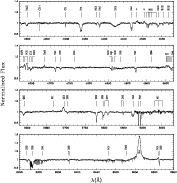 |
Figure 1:
Spectrum of HD149404 as observed with the FEROS spectrograph on HJD2451299.800 (
|
 |
Figure 1:
Spectrum of HD149404 as observed with the FEROS spectrograph on HJD2451299.800 (
|
Over the last decade, substantial progress has been achieved in our understanding of the interaction processes in early-type binary systems. It has been shown that some of the emission lines in the spectra of O-star binaries are at least partially formed in the wind interaction region (e.g. Thaller 1997). Observations of the phase-locked emission line profile variability can be used to constrain the geometry of the interaction region and allow us in principle to distinguish between a colliding wind phenomenon and a Roche lobe overflow (RLOF) process (e.g. Wiggs & Gies 1993; Rauw et al. 1999). A detailed analysis of the interaction phenomena in binaries in different evolutionary stages is therefore crucial for our understanding of stellar evolution as well as for a determination of the properties of the stellar winds of the binary components.
In the present paper, we discuss an extensive set of spectra of HD149404 (= HR6164 = V918Sco). Walborn (1972) assigned an O9Ia spectral type to the global spectrum of this system. Later on, it was discovered that some lines were actually double, but heavily blended (Conti et al. 1977). A first orbital solution was derived by Massey & Conti (1979) from a set of optical spectra, and another one was obtained by Stickland & Koch (1996) from IUE
observations (see Table 4).
Several spectral features of HD149404 point towards an interaction between the two components. In fact, Massey & Conti (1979) noticed the double-peaked structure of the H![]() emission profile in the spectrum of HD149404 and they interpreted this feature as a signature of an ongoing Roche lobe overflow process. More recently, Thaller (1998) suggested that the behaviour of the two H
emission profile in the spectrum of HD149404 and they interpreted this feature as a signature of an ongoing Roche lobe overflow process. More recently, Thaller (1998) suggested that the behaviour of the two H![]() peaks was due to a colliding wind interaction. HD149404 is also known to display the so-called "Struve-Sahade effect" (Stickland 1997). So far, the origin of this effect remains unclear although Gies
et al. (1997) suggest that it could result from photospheric heating by the X-ray emission generated in the wind interaction region.
peaks was due to a colliding wind interaction. HD149404 is also known to display the so-called "Struve-Sahade effect" (Stickland 1997). So far, the origin of this effect remains unclear although Gies
et al. (1997) suggest that it could result from photospheric heating by the X-ray emission generated in the wind interaction region.
This paper is organized as follows: the observations and the data reduction are presented in Sect.2 and the spectral features of HD149404 are discussed in Sect.3. Different techniques are used to measure the radial velocities of the absorption lines and a new orbital solution is derived in Sect.4. In Sect.5, we discuss the luminosity ratio of the binary components. As a next step, we examine the variations of the emission lines (Sect.6). Finally, we discuss a possible model for the interaction in HD149404 as well as the evolutionary status of the system (Sect.7).
Copyright ESO 2001